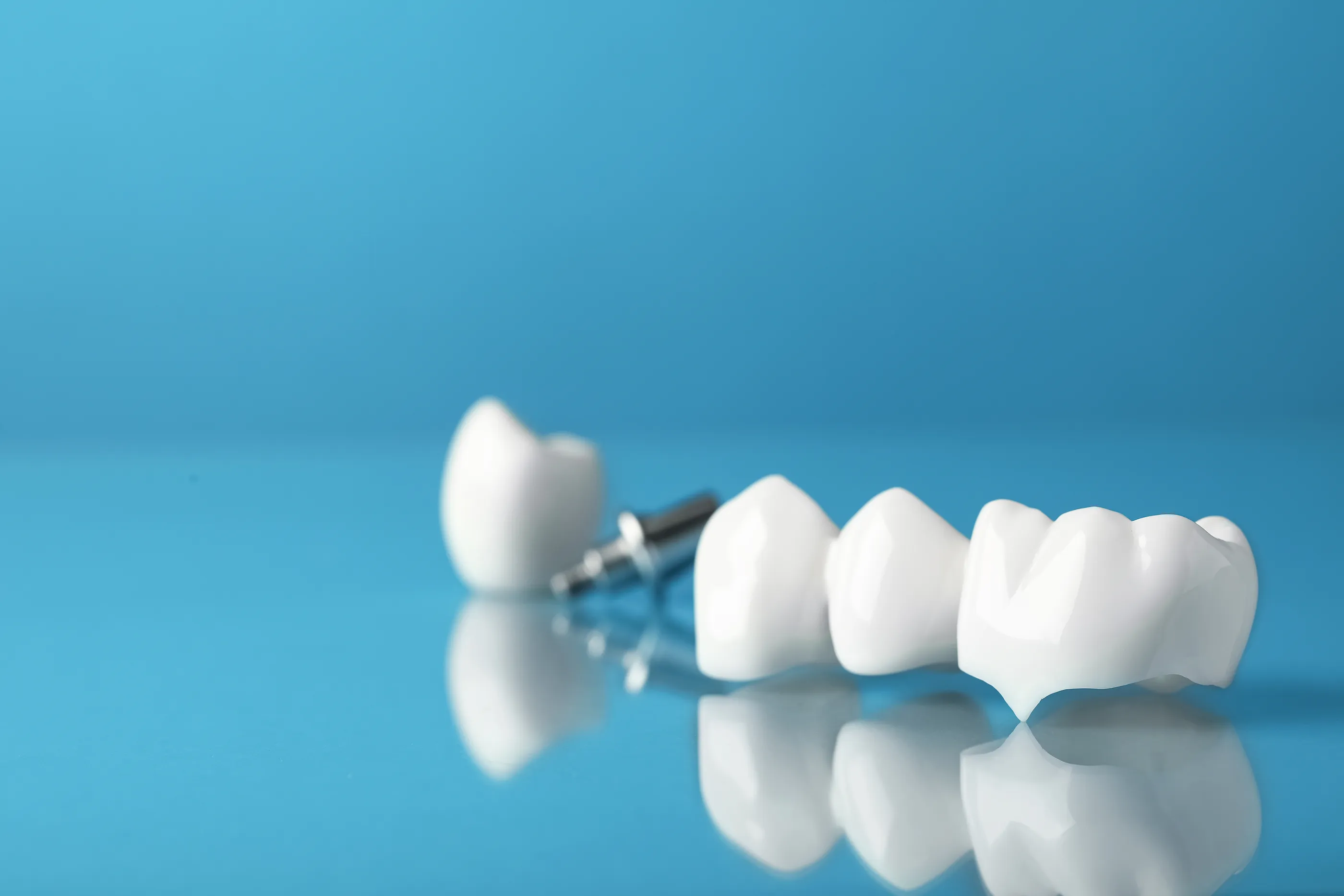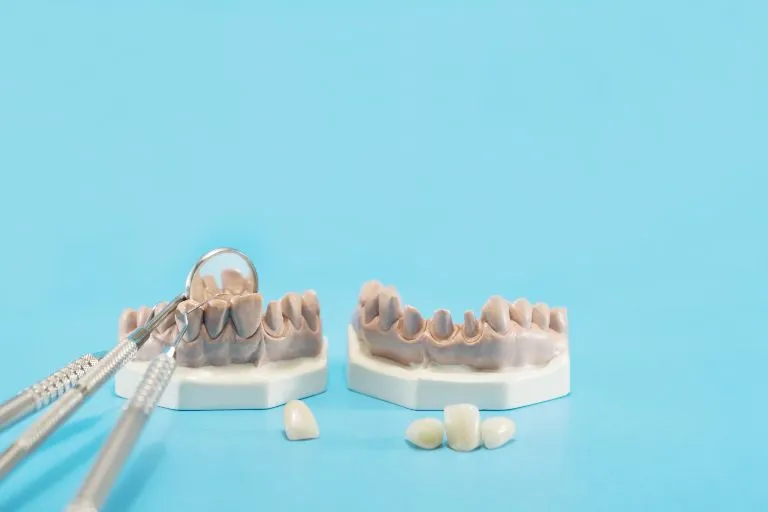Overview
Dental crowns are made of a variety of materials such as metal, resin, and porcelain. Dental crowns will last around 5-15 years with proper care. These tooth-shaped caps are used for weak, broken, or decayed teeth.

Dental crowns are tooth-shaped caps that restore decayed, broken, weak, or worn-down teeth. Crowns are also used to cover dental implants and root canal-treated teeth.
Dental crowns are made of a variety of materials such as metal, resin, and porcelain. Dental crowns will last around 5-15 years with proper care. These tooth-shaped caps are used for weak, broken, or decayed teeth.
If you have damaged or weakened teeth that can’t be fixed with fillings, a crown can help you. Although crowns are sometimes used for cosmetic reasons, they’re mainly needed due to a lack of remaining tooth structure. They can help cover the tooth to restore its shape and size, and strength, and improve its appearance. Crowns fit over the entire tooth, to ensure proper fit, dentists will need to remove a small amount of enamel bonding the new crown in place. A dental crown may be crafted from a variety of materials, including resin, metal, and porcelain.

Dental crowns can be used to cover a broken or decayed tooth when too much of the original tooth is missing, such as after root canal treatment. They may also be used to protect a weak tooth from breaking, cover stained to badly shaped teeth and even to hold a bridge or denture in place. Crowns serve several purposes. You may need a dental crown to:
Strengthen a weak tooth
Protect and support a cracked tooth
Restore a worn-down or broken tooth
Hold a dental bridge in place
Cover a severely stained or discolored tooth
Cover a root canal-treated tooth
Cover a dental implant
A dental crown is a tooth-shaped cap that covers the entire visible part of a damaged or decayed tooth. It can restore the tooth's shape, size, strength, and appearance. A dental crown usually requires two visits to the dentist. The first visit involves preparing the tooth and making an impression, and the second visit involves placing the permanent crown.
The cost of Dental Crown may vary based on the patient's specific needs, doctors' fees, and clinic fees.
With proper maintenance, your dental crowns should last around 15 years. Some can even last up to 30 years.
The possible disadvantages of crowns may include: placement over areas of untreated tooth decay, discomfort due to improper fitting, and increased risk of infection.
During the first visit, the dentist will examine the tooth and take X-rays to check the roots and surrounding bone. The dentist will then numb the tooth and the surrounding area with a local anesthetic. The dentist will then trim off some of the enamel from the tooth to make room for the crown. The amount of enamel removed depends on the type and thickness of the crown. The dentist will then take an impression of the prepared tooth and the opposite tooth using a putty-like material or a digital scanner. The impression will be sent to a dental laboratory where the crown will be made. The dentist will also choose the color of the crown that matches the natural teeth. The dentist will then place a temporary crown over the prepared tooth to protect it until the permanent crown is ready. The temporary crown is usually made of acrylic or metal and is held in place with temporary cement.
During the second visit, the dentist will remove the temporary crown and check the fit and color of the permanent crown. The dentist will then numb the tooth and the surrounding area with a local anesthetic. The dentist will then place the permanent crown over the prepared tooth and cement it in place with a special adhesive. The dentist will then check the bite and make any necessary adjustments. The dentist will also give instructions on how to care for the new crown, such as brushing, flossing, and avoiding hard or sticky foods. The dentist may also schedule a follow-up visit to monitor the crown and the tooth.
Equipped hospitals, and advanced specialized centers with experienced doctors and specialists are available in all medical treatment areas in Iran. Also, good hotels and entertainment centers have made Iran an appropriate choice for patients who are seeking dental crowns.

A dental crown is a procedure that involves placing a tooth-shaped cap over a damaged or decayed tooth to restore its shape, size, strength, and appearance. Dental crowns can improve the function and aesthetics of the teeth and last for many years with proper care. However, the cost and quality of dental crowns may vary depending on the country and the clinic where the procedure is performed. Iran is one of the countries that offers many advantages for dental crowns, such as:
Low cost: The cost of dental crowns in Iran is much lower than in other countries, such as the US, the UK, Canada, Australia, or Turkey. According to some sources, the average cost of a dental crown in Iran is about 150-250 USD per tooth, while in the US it can range from $800 to $1700 per tooth. This means that the patient can save up to 80% of the cost by choosing Iran as the destination for dental crowns. The low cost of dental crowns in Iran is due to the low cost of living, the favorable exchange rate, and the government subsidies for health care.
High quality: The quality of dental crowns in Iran is comparable to international standards, as the country has advanced dental equipment, modern clinics, and skilled dentists. The dentists in Iran are well-trained and experienced in performing various types of dental crowns, such as metal, porcelain-fused-to-metal, all-ceramic, or composite resin crowns. The dentists in Iran also follow strict hygiene and safety protocols to prevent infection and complications. The patient can expect to receive a natural-looking and durable dental crown in Iran that meets their needs and expectations.
Tourism opportunity: Iran is a fascinating tourist destination that offers a rich cultural and historical heritage, a diverse natural landscape, and a hospitable and friendly people. The patient can enjoy visiting the ancient monuments, museums, bazaars, mosques, and gardens that showcase the Persian civilization and culture. The patient can also explore the scenic mountains, deserts, forests, and islands that offer a variety of activities and attractions. The patient can also experience the Iranian cuisine, art, music, and festivals that reflect the diversity and vibrancy of Iranian society.
Iran is one of the countries that offers low-cost and high-quality dental crowns, making it an attractive destination for dental tourism. The average cost of a dental crown in Iran is 150-250 USD per tooth, while in the US it can range from $800 to $1700 per tooth. The low cost of dental crowns in Iran is due to the low cost of living, the favorable exchange rate, and the government subsidies for health care.
The quality of dental crowns in Iran is comparable to international standards, as the country has advanced dental equipment, modern clinics, and skilled dentists. The dentists in Iran are well-trained and experienced in performing various types of dental crowns, such as metal, porcelain-fused-to-metal, all-ceramic, or composite resin crowns. The dentists in Iran also follow strict hygiene and safety protocols to prevent infection and complications. The patient can expect to receive a natural-looking and durable dental crown in Iran that meets their needs and expectations.
Dental crown in Iran is a beneficial and affordable option for patients who need to restore their damaged or decayed teeth. Iran offers low-cost, high-quality, and tourism opportunities for dental crowns, making it an attractive and competitive destination for medical tourism.
Dental crowns are tooth-shaped caps that cover and protect damaged or decayed teeth. They can improve the function and appearance of the teeth and last for many years with proper care. However, there are different types of dental crowns, each made from different materials and serving various purposes. Some of the most common types of dental crowns are:
Metal crowns: These are made from gold, silver, or other alloys and are very durable and resistant to wear and tear. They can withstand high biting and chewing forces and rarely chip or break. However, they have a metallic color that may not match the natural teeth and may be more noticeable. They are usually used for back teeth that are not very visible.
Porcelain-fused-to-metal (PFM) crowns: These are made from a metal base with a porcelain layer on top. They combine the strength of metal with the aesthetics of porcelain and can match the color and shape of the natural teeth. However, they may wear down the opposing teeth and the metal may show through the porcelain over time. They are suitable for both front and back teeth.
All-ceramic or all-porcelain crowns: These are made entirely from ceramic or porcelain and have the most natural-looking appearance. They can mimic the translucency and color of the natural teeth and are biocompatible and hypoallergenic. However, they are more prone to chipping or cracking and may not be as strong as metal or PFM crowns. They are ideal for front teeth and for people with metal allergies.
Zirconia crowns: These are made from zirconium dioxide, a type of ceramic that is very strong and durable. They can withstand high biting and chewing forces and are less likely to chip or break. They also have a natural-looking appearance and can match the color and shape of the natural teeth. However, they may require more tooth preparation and may wear down the opposing teeth. They are suitable for both front and back teeth.
Composite resin crowns: These are made from a resin-based material that is tooth-colored and can be easily shaped and bonded to the tooth. They are less expensive and less invasive than other types of crowns and can be done in one visit. However, they are more susceptible to staining, discoloration, and wear and tear and may not last as long as other types of crowns. They are usually used for temporary or cosmetic purposes.
The type of dental crown that is best for each patient depends on several factors, such as the location, condition, and function of the tooth, the cost and availability of the material, and the preference and expectation of the patient. The dentist will evaluate the patient's oral health and discuss the pros and cons of each type of crown before recommending the most suitable option.
The recovery period after getting a dental crown is typically a few days, during which some pain, discomfort, and sensitivity may occur. These symptoms can be managed with over-the-counter painkillers, such as ibuprofen, and topical anesthetic gels. It is also advisable to avoid hot or cold foods and drinks, as well as sticky or hard foods until the crown is fully set and the inflammation subsides.
To care for the dental crown and the surrounding gums, it is important to maintain good oral hygiene habits, such as brushing twice a day, flossing daily, and using mouthwash. However, care should be taken not to dislodge the crown or irritate the gums when flossing around the crowned tooth. A toothpaste for sensitive teeth may also help to reduce the sensitivity of the crown.
Additionally, some bad habits should be avoided to prevent damaging the crown or the underlying tooth, such as biting on nails, chewing on ice, opening bottles with teeth, or grinding teeth. If these habits are difficult to quit, a dentist may recommend wearing a mouth guard or a splint to protect the teeth and the crowns.
Patients should attend regular dental check-ups and follow-up appointments to monitor the condition of the crown and the tooth and to detect and treat any potential problems, such as cracks, decay, or infection. A dental crown can last for 10 to 15 years or longer, depending on the material, the quality of the placement, and the oral care of the patient.